Most social media strategies start and stop with the content calendar. But there’s one underrated tactic brands of any size should be taking advantage of: commenting.
Commenting is not just a supportive gesture; it’s a strategic move. Whether you’re a solo creator, a startup, or a global brand, how and where you show up in comment sections can shape perception, build relationships, and expand your reach in ways a single feed post often can’t.
Think of it this way: while posting is the backbone of social media, commenting is the connective tissue. The backbone gives your brand structure and presence, but without connective tissue, your strategy lacks mobility, flexibility, and connection. Comment sections have become where the real action happens—where conversations spark, relationships take root, and brands stop shouting into the void and start becoming a part of the culture.
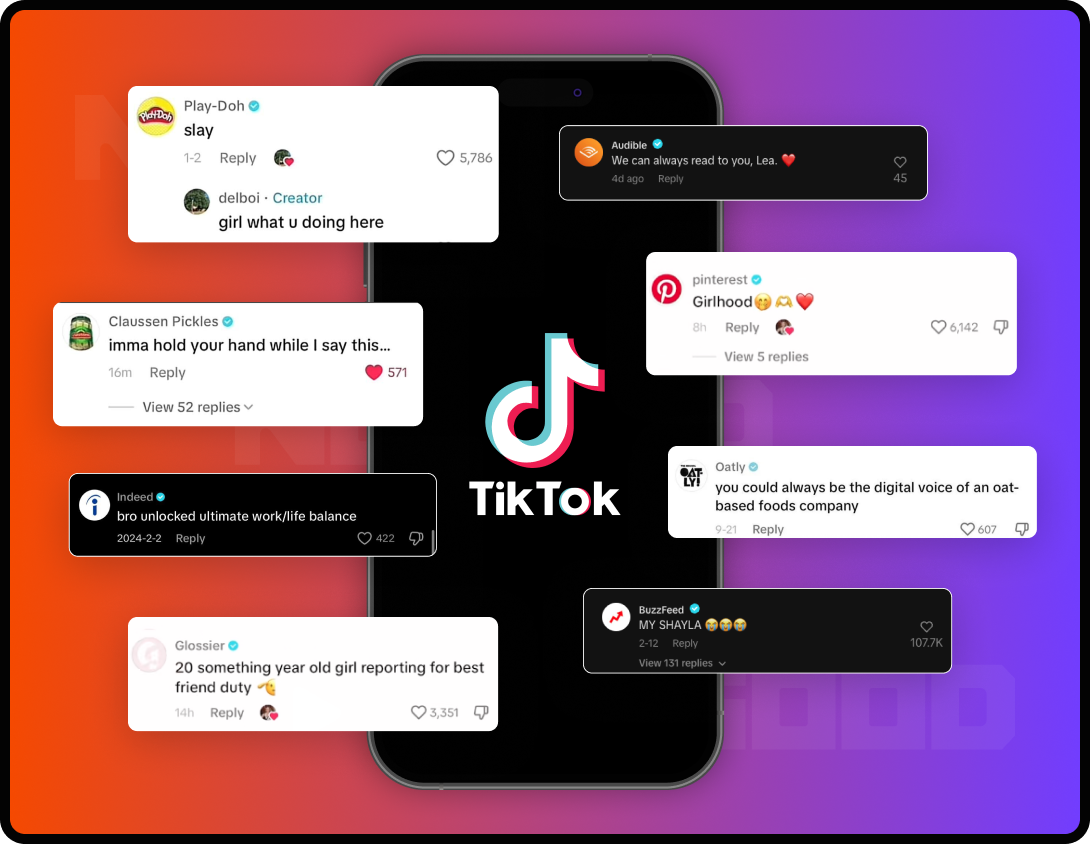
In this article, we’ll explore how commenting can serve as a core part of your social strategy—from the psychology behind it, to styles that work, to real-world winning examples of how brands use comments to win attention and affinity.
Why Commenting as a Brand Deserves a Seat at the Table
Many brands and creators overlook commenting, yet it’s one of the most high-impact, low-effort ways to grow visibility, build credibility, and stay culturally relevant. This makes commenting a scalable way to stay visible.
Commenting is simply another medium to get eyes on your brand without content creation burnout. Not every touchpoint with your audience needs to come from a feed post or paid social ad. Comments allow your brand to show up consistently without the heavy lift of production.
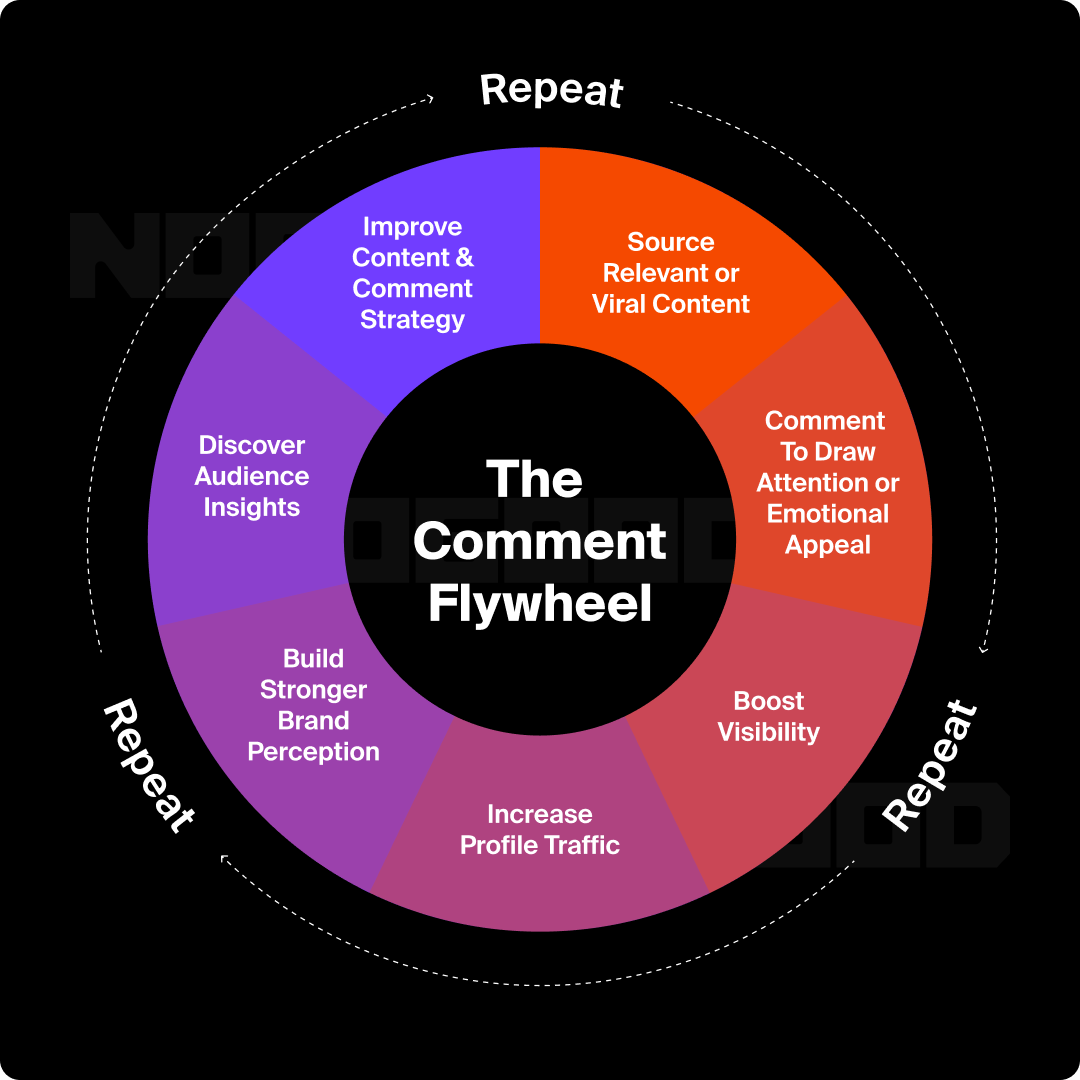
But it’s not just about visibility—there’s a technical advantage too. Most social platform algorithms reward accounts that interact meaningfully with others, especially those that contribute to active conversations. When brands consistently take these actions, their accounts stay algorithmically “warm”, increasing the chances of appearing in more feeds, explore pages, and recommended sections.
Want your brand to embed itself in cultural moments fast? Commenting allows brands to creatively earn relevance in larger communities. You don’t need to own the conversation to benefit from it. That’s where most brands get stuck. Just being present in the right threads of comments can build association and strong exposure. This is crucial for smaller brands that are starting from scratch, as consistent, smart commenting can help build credibility in saturated, competitive social spaces.
Finally, reading and participating in viral comment sections is an opportunity for your brand to receive real-time insights into what your audience cares about. These discussions give you unfiltered access to your audience’s tone, interests, frustrations, and language. It’s an organic social listening tool at your fingertips. Here you can answer the questions:
- What questions show up repeatedly?
- What types of content or topics are sparking viral comment sections?
- Whose comments are rising to the top, and what makes them stand out?
- What tone of voice is getting the strongest reactions—humor, bold takes, vulnerability, expertise?
- Are there gaps or questions going unanswered that your brand could step in and respond to?
Brands Are Being Summoned
More and more, creators are summoning brands to engage directly with their content with the expectation that they’ll respond in ways that are humorous, unhinged, chaotic, or entirely unexpected. It’s no longer strange to see a creator say, “@Duolingo, don’t be shy,” or bait a brand with a challenge, roast, or request of a niche meme. These are invitations, not just mentions. It’s performative, yes—but it’s also strategic.
Creators understand that a brand comment can spike their content’s visibility and drive attention. And in return, the brand gets a moment in the spotlight, too. It’s a win-win situation.
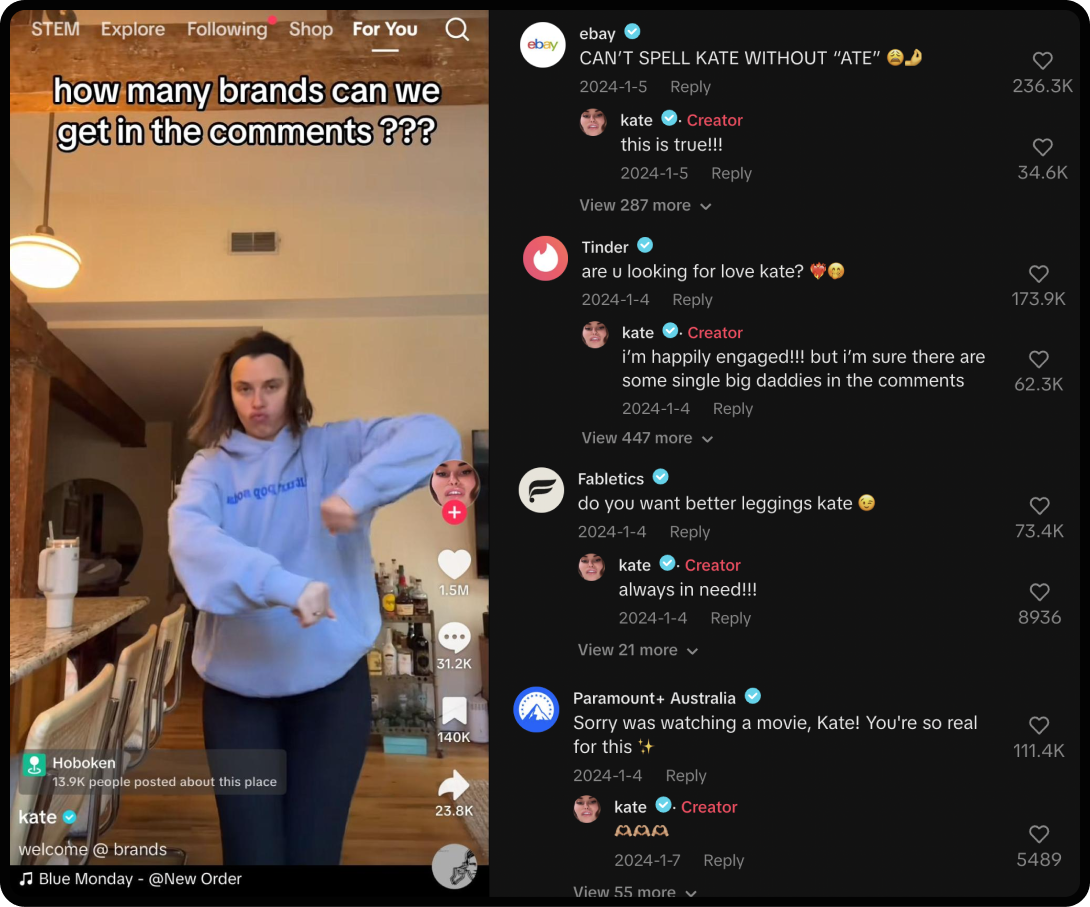
But even if your brand isn’t being summoned yet, that doesn’t mean you should wait to be invited. This style of interaction has become a crucial part of the entertainment value on social media, specifically on TikTok. The brands that earn engagement today are playing along, embracing personality, and proving they understand the nature of social.
POV: The Comment Is The Content
Still not sold on a commenting strategy? Here’s your proof. The brands seeing the most success on social media are not passively participating in conversations; they are becoming the content itself. One smart, funny, or unexpected comment can get screenshotted, stitched, or turned into an entire TikTok or meme, without your team lifting a finger.

This is organic brand exposure you simply can’t buy! If you can compel a user to amplify your voice with no buy-in, you’ve won! Strive to be the story, not another voice in the void.
The Psychology Behind Commenting
Social media isn’t just a broadcast channel, it’s a connection machine. At its core, it’s driven by three human impulses: connection, validation, and curiosity. That’s where commenting thrives.
Emotion is the currency of engagement. If your brand is commenting vaguely or without channel-native language, it won’t land. Comments that make people laugh, feel seen, or offer something useful cut through the noise. When a brand sparks an emotional nerve via humor, relatability, or insight, it’s more likely to stand out. When a witty comment comes from a brand, it hits harder. Why? Because most brands play it safe. So when one breaks character, or rather creates a strong one, it stands out even more. Extra points for Gen-Z fluent language.
Give a little love in the comments and watch it come back tenfold. When a brand comments, it opens the door for others to engage back. People are wired to return favor and attention. A single, well-written comment can lead to likes, follows, DMs, or even loyal fans.
Familiarity breeds trust. A brand name consistently showing up strong in comment sections, across a select topic, or in viral internet moments, builds subtle but powerful recognition. Over time, your brand becomes a known voice, trusted for what you say and for being part of the conversation at all.
Low-stakes, high-impact. Comments are small, low-lift actions that keep your brand top of mind, just by showing up where people are already paying attention. It strips away the formality and makes your brand feel human, not corporate.
The Art of Commenting Across Channels
Not all social media platforms are created equal, and neither are comments. Commenting as a brand should be more than just reacting. It’s an easy strategic tactic to express a brand voice in order to build credibility and strengthen connections with audiences. The strongest strategies aren’t random; they’re intentional and platform-specific.
Over the past year, brand accounts have increasingly taken the risk of showing up in the comments with casual, witty, sarcastic, even unhinged, remarks. What stands out is that many of these comments appear on content completely unrelated to the brand itself, often viral videos. This unexpected participation not only catches people off guard, but it also amplifies reactions, laughs, shares, and sometimes even headlines. But this approach isn’t quite groundbreaking. Wendy’s pioneered this tactic nearly a decade ago on Twitter, setting an early blueprint for brands to ditch stiff corporate speak in favor of humor, sass, and real-time banter.
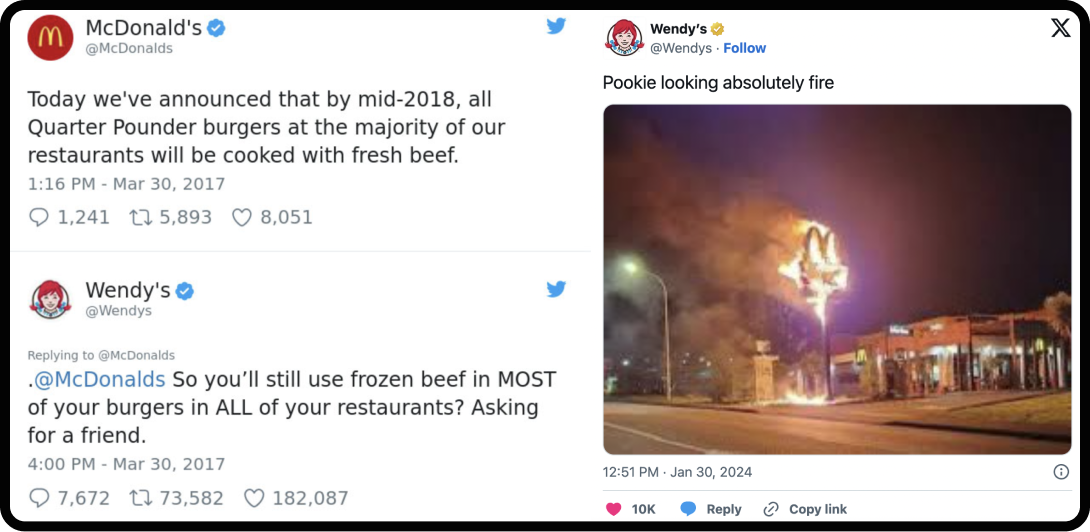
For years, Twitter was considered the main platform where brands had permission to loosen up, unlike Instagram or Facebook, which remained polished and promotional. That dynamic shifted when TikTok exploded. Its rise and Gen-Z-heavy audience rewired expectations across all social platforms, rewarding chaotic humor, relatability, personality, and quick cultural reactions.
But don’t be fooled, actively monitoring trending conversations and evolving social language takes real effort. Slang shifts fast, and cultural moments can disappear just as quickly as they emerge. The key is to identify spaces where your brand can show up naturally and add something to catch attention. Relevance doesn’t come from forcing your way into the conversation, it comes from speaking the way your audience already does.
The ROI of Commenting
A single strong comment can convert to a follow, start a conversation, or even lead to a sale. While some might think it’s just social small talk, it’s a strategy that has proven to drive real results for brands of any size.
Visibility That Converts
When your brand lands a top comment on a viral post and live comment section, you’re certain to get attention and earn exposure. The ripple effect is real: top comments often lead curious users to your profile, resulting in a measurable spike in profile views, video views, and ideally, followers. This kind of passive discovery is the modern version of word-of-mouth marketing.
From Comments, to Conversations, to Customers
Engaging in the right comment sections, where your target audience lingers, can lead to unexpected business outcomes. Smart and/or humorous comments can be the gateway to genuine leads from people who had no idea your brand existed before. Whether someone witnessed your comment or was part of the conversation, the single action of commenting can shift perception. Suddenly, your product or service isn’t just a need; it’s a want. It’s low-cost, low-effort outreach that feels more authentic than traditional ads in today’s social environment.
Algorithmic Momentum
Social platforms reward activity. That may sound overwhelming, however, this doesn’t always mean cranking out more high-quality feed posts. Activity includes meaningful engagement. When your brand appears in comment sections and evokes any kind of emotion, you’re fueling the algorithm with the kind of activity it runs on. This kind of “comment currency” keeps your profile warm and active, increasing the chances your future posts land in more feeds, Explore pages, and suggested follow lists. It’s organic visibility, without the paid boost.
Qualitative Wins That Compound Over Time
Beyond the metrics, consistent and powerful commenting strengthens brand perception. It humanizes the brand with personality, builds trust, and familiarity. Over time, you become known less for what you post and more for how you show up as a social consumer like everyone else.
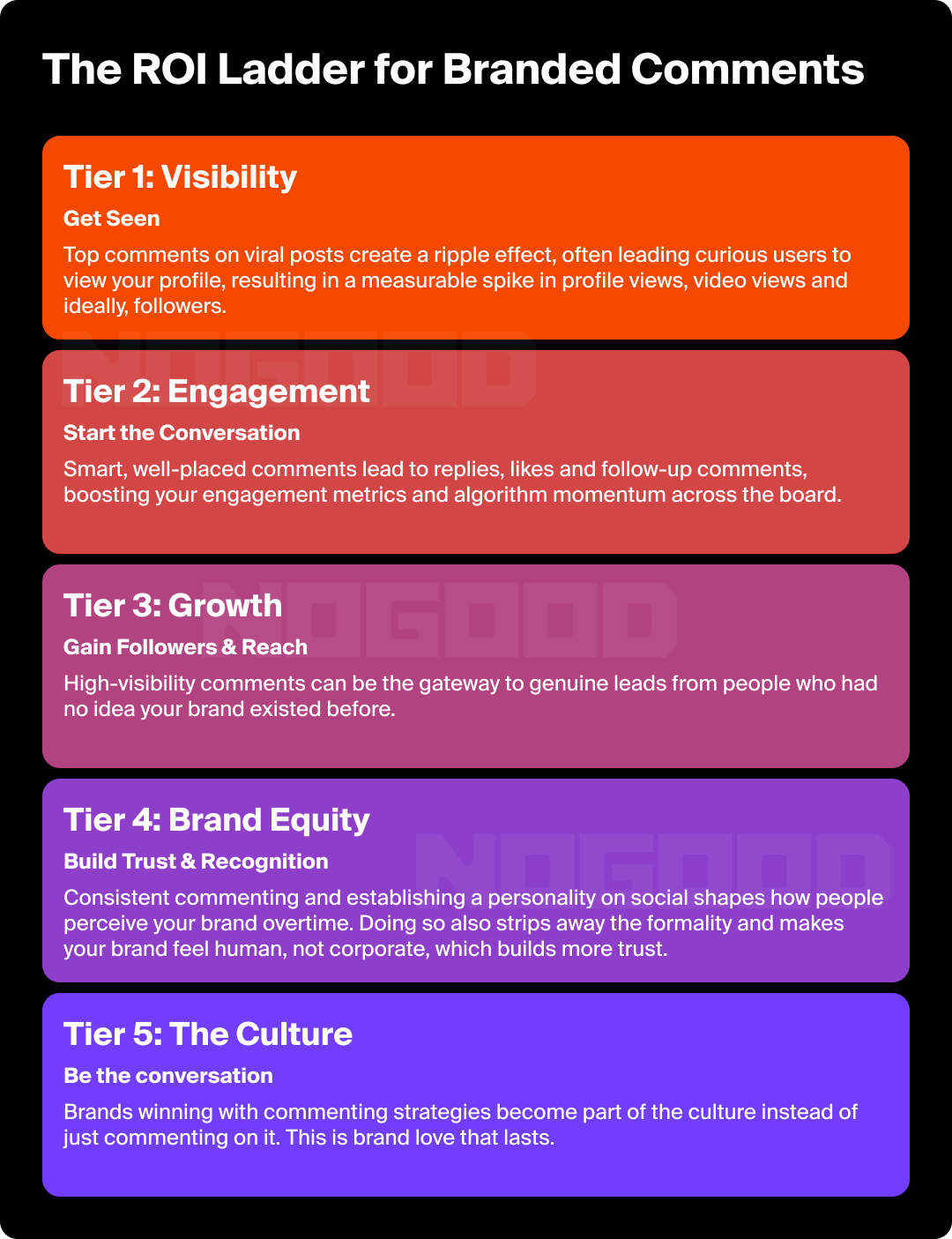
Pro tip: Track your top-performing comments the same way you would a feed post. Analyze patterns of strong likes, replies, profile visits, and any downstream engagement you likely source from a comment. This strategic tactic isn’t just PR or “extra credit” anymore; it’s part of your growth engine.
Standout Brand Comments That Nailed It
So, which brand accounts are getting it right? Back in 2023, there were only a few—now in 2025, a lot of B2C and B2B brands alike have caught on. Through wit, chaos, or charm, these standout accounts prove that commenting can be a strategic art form. Let’s look at how Ryanair, Empire State Building, Sour Patch Kids, and Scrub Daddy have turned the comment section into their content playground.
The Irish ultra-low-cost airline group, Ryanair, has mastered the art of turning social media engagement into a brand-defining strategy. Their approach is marked by a bold, irreverent tone that resonates across platforms, particularly in the TikTok comment sections where their audience eagerly anticipates their witty reports.
This strategy is not accidental; it’s a deliberate effort to humanize the brand. By embracing a most often cheeky style, Ryanair has cultivated a loyal online following that appreciates their candidness and humor.
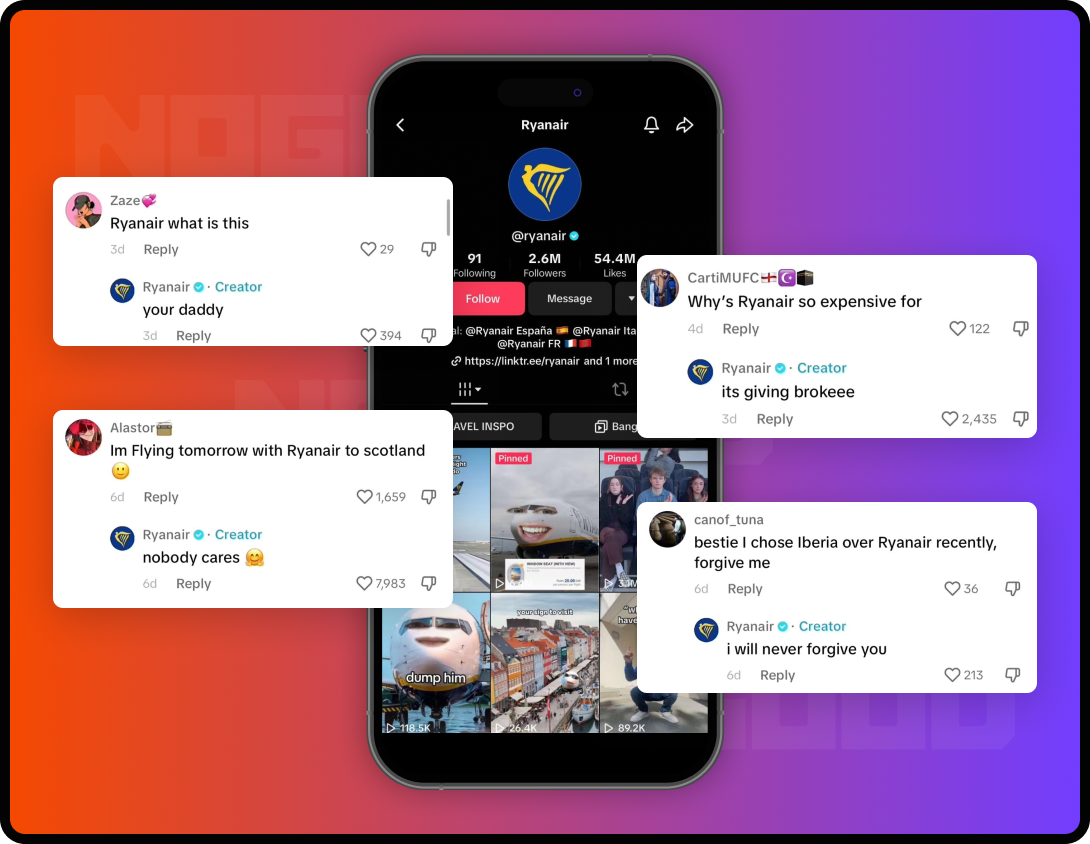
Ryanair was one of the first brands to take the risk of showing up in social conversations with bold, unapologetic humor. In doing so, they helped redefine how brands—especially airlines—show up online, setting the tone with edge, personality, and cultural fluency. Their team’s agility in responding to comments with timely and humorous replies sets them apart even more.
Ryanair is certainly not alone. The Empire State Building surprised audiences by abandoning its buttoned-up image for chaotic, meme-savvy replies, showing that even iconic institutions can win on social media when they tap into internet culture.
Sour Patch Kids delivers their signature sweet-and-sour personality in the comments, often responding directly to videos about their candy (or roasting competitors) with clever, bi-polar sass.
Scrub Daddy has mastered the art of creative intervention. They’ve jumped into comment sections about cleaning, competitors, or even totally unrelated content with sharp wit that drives visibility.

Whether they’re reacting to content about their product or inserting themselves in broader conversations, these brands have cracked the code: consistent, culturally fluent commenting builds community, buzz, and social power.
Commenting Etiquette and Mistakes to Avoid
Like most things in life, balance is key. Once you see the impact of commenting, it may be tempting to comment on every viral post you come across. But without intention, you can do just as much harm as good. Don’t be the brand that forgets: how you comment matters just as much as where—and how often—you do.
And when brands get it wrong, the internet talks back. Audiences are quick to call out brands, whether it be a tone-deaf comment, an off-brand attempt at humor, or a clumsy AI-generated reply. In some cases, users even create content specifically to bash brands with weak and out-of-touch comments.

To avoid a PR misfire from a singular comment, here are six essentials to keep in mind to build and execute a successful commenting strategy:
- Skip The Fluff: Generic comments like “Love this!” or a random list of emojis add zero value. If your brand doesn’t have something impactful to say, keep on moving.
- Don’t Hijack The Thread: Avoid dropping links or any self-promotional plugs. It’s a quick way to lose trust and feel like spam.
- Stay On-Brand: Comments are an extension of your brand voice—and a more intimate one at that. Chasing clout with off-brand language might grab attention, but lead to eroding long-term trust.
- Be Quick or Don’t Bother: Relevance has a quick shelf life. If you jump into a viral thread 3 days in, it makes your brand look behind. Be in the first 20 comments, or else your comment will get buried.
- Know When To Sit Out: Just because something is happening, doesn’t mean it makes sense for your brand to jump in. Learn when to sit back and observe from the sidelines.
- Don’t Let AI Take Over: AI can be helpful, but soulless, irrelevant comments are brand kryptonite. Use AI to enhance your ideas, not replace human instinct.
As brands navigate the do’s and don’ts of commenting, remember: each comment is a chance to build stronger connections and position your brand as a relatable voice in the community.
Systems for Scalable Commenting
Commenting on social media doesn’t have to be chaotic and unorganized. Here are three smart systems to build in order to track effectiveness and scale:
- Make commenting a daily habit.
Spend 10–15 minutes each day engaging with key creators, niche communities, or meme hubs your audience would likely follow or engage with. Keep a live tracker of priority accounts and topics, and show up with intention. This small, consistent ritual increases your chances of high-impact visibility.
- Use AI to scale without losing your voice.
AI can help generate comment options in different tones, flag trending posts worth engaging with, or surface viral conversations in your niche. Think of it as your creative co-pilot—helpful for scale, not a replacement for human instinct.
- Assign ownership. Track impact.
Like any other part of your content strategy, commenting needs a clear owner. Designate someone to lead the charge, ideally the most “tapped in” person on your team. Set specific goals (profile visits, DMs, shares, brand mentions) and track results over time. It’s a small effort with big potential returns.
Social Media Marketing Doesn’t Stop at the Feed
Brand voice in the comments is just as much a part of your brand’s social strategy as any feed post. Every reply is a chance to show personality, build recognition, and earn trust in a low-lift, high-reward way.
Treat comments like mini-posts. If nothing else, be unexpected and funny. Start with one a day, and watch how showing up smartly in comment sections drives powerful results.







In this blog, “Commenting as a Social Media Strategy” highlights how thoughtful replies can supercharge engagement and build authentic brand communities.
Insightful piece, Berkley! 🔥
You’ve highlighted a game changing yet often overlooked aspect of social media strategy: commenting. As you aptly note, stopping at a content calendar is only half the battle true growth lies in the conversations brands build through thoughtful replies
Two points particularly resonated:
1:1 engagement over metric chasing As one Reddit marketer pointed out, “talking to users in the comments creates organic, 1:1 interactions…that leaves a much stronger impression than just viewing a post”
reddit.com
. That emphasis on real interaction makes all the difference.
Strategic, not spammy You wisely emphasize meaningful commenting rather than scattershot replies. It’s not about volume; it’s about relevance and authenticity—precisely what wins attention and builds community trust.
A suggestion: maybe include a real-world example or mini case study—like how a brand turned a critical comment into a long-term customer through their approach. That kind of tangible proof can inspire other teams to adopt the tactic.
Thanks for making the case so clearly and for reminding us that social media is, above all, social. Looking forward to trying this and seeing what kind of impact it delivers!
Great read! 👏 You’ve elevated brand commenting from “nice‑to‑have” to a strategic play—one that builds visibility, warmth, and algorithmic momentum all at once. Seeing real-world examples like Ryanair and Scrub Daddy makes the tactic feel not only doable, but smart and scalable.
It’s interesting how some brands always appear in the right comment threads! This article shows that commenting is a smart social media strategy. I liked the idea that comments aren’t just replies they help start conversations and connect with people. Even small, thoughtful comments can get attention, build trust, and increase visibility. I will pay more attention to how we use comments from now on. Thanks for sharing these practical tips!
This piece nails an often-overlooked truth: comments are content. I like how it reframes commenting from a side activity into a core growth tactic—showing how witty, timely remarks can fuel visibility, algorithmic reach, and brand personality just as much as (sometimes even more than) a feed post.